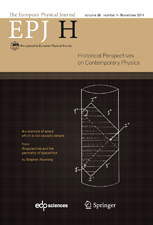Credit: Springer
Fusion research has been dominated by the search for a suitable way of ensuring confinement as part of the research into using fusion to generate energy. In a recent paper published in EPJ H, Fritz Wagner from the Max Planck Institute for Plasma Physics in Germany, gives a historical perspective outlining how our gradual understanding of improved confinement regimes for what are referred to as toroidal fusion plasmas—confined in a donut shape using strong magnetic fields— have developed since the 1980s. He explains the extent to which physicists' understanding of the mechanisms governing turbulent transport in such high-temperature plasmas has been critical in improving the advances towards harvesting fusion energy.
The release of energy from fusion processes between deuterons and tritons (DT-fusion) requires high temperatures to overcome the Coulomb potential, high density for frequent collisions and a high energy confinement time. Plasma is composed of light negative and heavy positive charges with strongly different mobilities. However, increasing the pressure by additional heating to bring the plasma closer to the fusion conditions causes turbulence to become more violent so that plasma confinement is degraded.
The level of adverse turbulence ultimately reduces the prospects of fusion. Physicists found in the 1980s that toroidally shaped plasmas of the tokamak type offer a path to low turbulence thanks to their ability to self-organise. Over the course of the past 30 to 40 years, they came to realise that turbulence and plasma flow are linked and regulate each other. Indeed, they found that the spatial variation of the plasma flow regulates the turbulence of the drift-wave type. They also found that this mechanism is another example of a self-organisation process known for a long time in geophysical fluid dynamics.
More information: F. Wagner, The history of research into improved confinementregimes, The European Physical Journal H (2017). DOI: 10.1140/epjh/e2016-70064-9
Provided by Springer
























